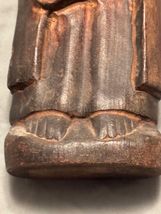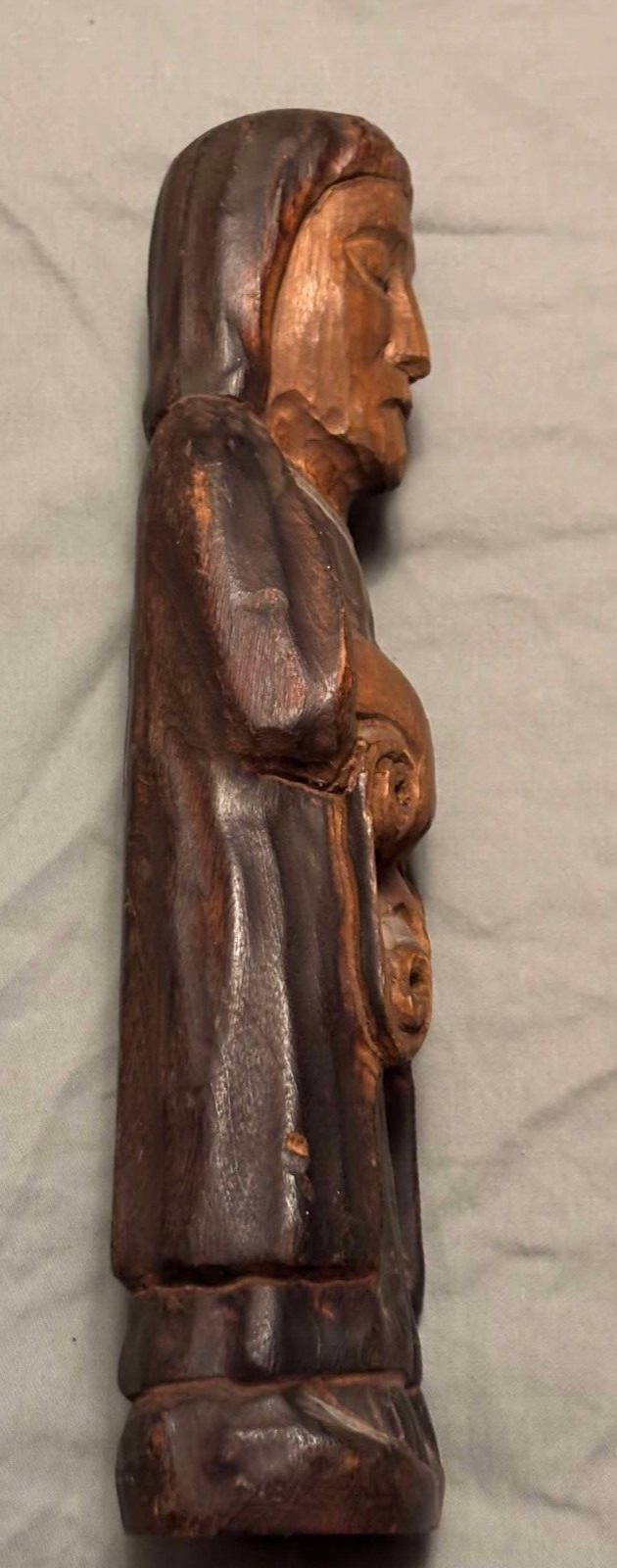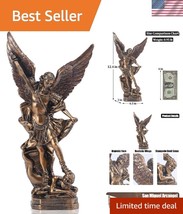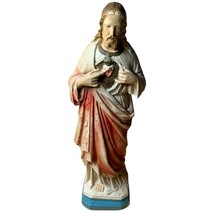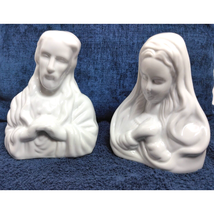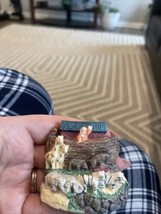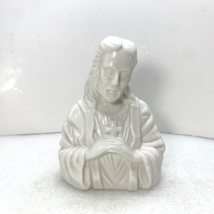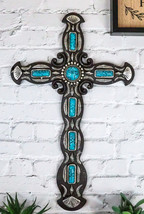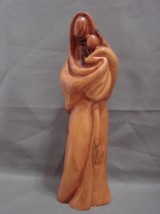Old Santos Folk Art Saint Augustine St and 50 similar items
OLD SANTOS FOLK ART SAINT AUGUSTINE ST FRANCIS de SALES NAIVE WOOD SCULPTURE
View full item details »
Shipping options
Offer policy
OBO - Seller accepts offers on this item.
Details
Return policy
Purchase protection
Payment options
PayPal accepted
PayPal Credit accepted
Venmo accepted
PayPal, MasterCard, Visa, Discover, and American Express accepted
Maestro accepted
Amazon Pay accepted
Nuvei accepted
View full item details »
Shipping options
Offer policy
OBO - Seller accepts offers on this item.
Details
Return policy
Purchase protection
Payment options
PayPal accepted
PayPal Credit accepted
Venmo accepted
PayPal, MasterCard, Visa, Discover, and American Express accepted
Maestro accepted
Amazon Pay accepted
Nuvei accepted
Item traits
| Category: | |
|---|---|
| Quantity Available: |
Only one in stock, order soon |
| Condition: |
Used |
| Figure: |
Saints |
| Material: |
Wood |
| Country/Region of Manufacture: |
Unknown |
| Handmade: |
Yes |
| Religion: |
Christianity |
Listing details
| Shipping discount: |
Shipping weights of all items added together for savings. |
|---|---|
| Posted for sale: |
More than a week ago |
| Item number: |
1730356389 |
Item description
OLD SANTOS FOLK ART SAINT AUGUSTINE ST FRANCIS de SALES NAIVE WOOD SCULPTURE
Description
GREETINGS, FEEL FREE
TO
"SHOP NAKED."
We deal in items we believe others will enjoy and want to purchase.
We are not experts.
We welcome any comments, questions, or concerns.
WE ARE TARGETING A GLOBAL MARKET PLACE.
Thanks in advance for your patronage.
Please Be sure to add WDG to your favorites list!
NOW FOR YOUR VIEWING PLEASURE?
ONE OF A KIND / OOAK
ARTIST ORIGINAL / AO
UNSIGNED ANTIQUE RELIC
ATTRIBUTING THE FIGURE AS
SAINT AUGUSTINE
OR
ST FRANCIS de SALES
THE PATRON SAINT OF WRITERS / JOURNALISTS / ANTHOLOGISTS
WOOD CARVING IS ABOUT 13" HIGH BY 3" WIDE
CARVED EFFIGY IS LIKLEY COTTON WOOD
FINE PATENA
ESTIMATED NEAR 100 YEARS OLD
NAIVE / PRIMITIVE EFFIGY
BEARING A SCROLL
---------------------------------------------
FYI
Augustine of Hippo (/?????st?n/ aw-GUST-in, US also /?????sti?n/ AW-g?-steen; Latin: Aurelius Augustinus Hipponensis; 13 November 354 ? 28 August 430), also known as Saint Augustine and in the Eastern Orthodox Church as Blessed Augustine, was a theologian and philosopher of Berber origin and the bishop of Hippo Regius in Numidia, Roman North Africa. His writings deeply influenced the development of Western philosophy and Western Christianity, and he is viewed as one of the most important Church Fathers of the Latin Church in the Patristic Period. His many important works include The City of God, On Christian Doctrine, and Confessions.
According to his contemporary, Jerome of Stridon, Augustine "established anew the ancient Faith". In his youth he was drawn to the Manichaean faith, and later to the Hellenistic philosophy of Neoplatonism. After his conversion to Christianity and baptism in 386, Augustine developed his own approach to philosophy and theology, accommodating a variety of methods and perspectives. Believing the grace of Christ was indispensable to human freedom, he helped formulate the doctrine of original sin and made significant contributions to the development of just war theory. When the Western Roman Empire began to disintegrate, Augustine imagined the Church as a spiritual City of God, distinct from the material Earthly City. The segment of the Church that adhered to the concept of the Trinity as defined by the Council of Nicaea and the Council of Constantinople closely identified with Augustine's On the Trinity.
Augustine is recognized as a saint in the Catholic Church, the Eastern Orthodox Church, the Lutheran churches, and the Anglican Communion. He is also a preeminent Catholic Doctor of the Church and the patron of the Augustinians. His memorial is celebrated on 28 August, the day of his death. Augustine is the patron saint of brewers, printers, theologians, and a number of cities and dioceses. His thoughts profoundly influenced the medieval worldview. Many Protestants, especially Calvinists and Lutherans, consider him one of the theological fathers of the Protestant Reformation due to his teachings on salvation and divine grace. Protestant Reformers generally, and Martin Luther in particular, held Augustine in preeminence among early Church Fathers. From 1505 to 1521, Luther was a member of the Order of the Augustinian Eremites.
In the East, his teachings are more disputed and were notably attacked by John Romanides, but other theologians and figures of the Eastern Orthodox Church have shown significant approbation of his writings, chiefly Georges Florovsky. The most controversial doctrine associated with him, the filioque, was rejected by the Eastern Orthodox Church. Other disputed teachings include his views on original sin, the doctrine of grace, and predestination. Though considered to be mistaken on some points, he is still considered a saint and has influenced some Eastern Church Fathers, most notably Gregory Palamas. In the Greek and Russian Orthodox Churches, his feast day is celebrated on 15 June.
The historian Diarmaid MacCulloch has written: "Augustine's impact on Western Christian thought can hardly be overstated; only his beloved example, Paul of Tarsus, has been more influential, and Westerners have generally seen Paul through Augustine's eyes.
Death and sainthood
Shortly before Augustine's death, the Vandals, a Germanic tribe that had converted to Arianism, invaded Roman Africa. The Vandals besieged Hippo in the spring of 430 when Augustine entered his final illness. According to Possidius, one of the few miracles attributed to Augustine, the healing of an ill man, took place during the siege. Augustine has been cited to have excommunicated himself upon the approach of his death in an act of public penance and solidarity with sinners. Spending his final days in prayer and repentance, he requested the penitential Psalms of David be hung on his walls so he could read them and upon which led him to "[weep] freely and constantly" according to Possidius' biography. He directed the library of the church in Hippo and all the books therein should be carefully preserved. He died on 28 August 430. Shortly after his death, the Vandals lifted the siege of Hippo, but they returned soon after and burned the city. They destroyed all but Augustine's cathedral and library, which they left untouched.
Augustine was canonized by popular acclaim, and later recognized as a Doctor of the Church in 1298 by Pope Boniface VIII. His feast day is 28 August, the day on which he died. He is considered the patron saint of brewers, printers, theologians, and a number of cities and dioceses. He is invoked against sore eyes.
Augustine is remembered in the Church of England's calendar of saints with a lesser festival on 28 August.
Relics
According to Bede's True Martyrology, Augustine's body was later translated or moved to Cagliari, Sardinia, by the Catholic bishops expelled from North Africa by Huneric. Around 720, his remains were transported again by Peter, bishop of Pavia and uncle of the Lombard king Liutprand, to the church of San Pietro in Ciel d'Oro in Pavia, to save them from frequent coastal raids by Saracens. In January 1327, Pope John XXII issued the papal bull Veneranda Santorum Patrum, in which he appointed the Augustinians guardians of the tomb of Augustine (called Arca), which was remade in 1362 and elaborately carved with bas-reliefs of scenes from Augustine's life, created by Giovanni di Balduccio.
In October 1695, some workmen in the Church of San Pietro in Ciel d'Oro in Pavia discovered a marble box containing human bones (including part of a skull). A dispute arose between the Augustinian hermits (Order of Saint Augustine) and the regular canons (Canons Regular of Saint Augustine) as to whether these were the bones of Augustine. The hermits did not believe so; the canons affirmed they were. Eventually Pope Benedict XIII (1724?1730) directed the Bishop of Pavia, Monsignor Pertusati, to make a determination. The bishop declared that, in his opinion, the bones were those of Augustine.
The Augustinians were expelled from Pavia in 1785, Augustine's ark and relics were brought to Pavia Cathedral in 1799. San Pietro fell into disrepair but was finally restored in the 1870s, under the urging of Agostino Gaetano Riboldi, and reconsecrated in 1896 when the relics of Augustine and the shrine were once again reinstalled.
In 1842, a portion of Augustine's right arm (cubitus) was secured from Pavia and returned to Annaba. It now rests in the Saint Augustin Basilica within a glass tube inserted into the arm of a life-size marble statue of the saint.
----------------
Francis de Sales, C.O., O.M. (French: Francois de Sales; Italian: Francesco di Sales; 21 August 1567 ? 28 December 1622) was a Savoyard Catholic prelate who served as Bishop of Geneva and is a saint of the Catholic Church. He became noted for his deep faith and his gentle approach to the religious divisions in his land resulting from the Protestant Reformation. He is known also for his writings on the topic of spiritual direction and spiritual formation, particularly the Introduction to the Devout Life and the Treatise on the Love of God.
Life: Early years
Francis de Sales was born two months premature on 21 August 1567 in the Chateau de Sales into the noble Sales family of the Duchy of Savoy, in what is today Thorens-Glieres, Haute-Savoie, France. His father was Francois de Sales, Lord of Sales, and Novel, and by marriage, de Boisy. His mother was a noblewoman, Francoise de Sionnaz, the only child of the prominent magistrate, Melchior de Sionnaz, Seigneur de Vallieres, de la Thuile, and de Boisy. This being one of the noblest families in Savoy, Francis's father was generally known as M. de Boisy.
He was baptized Francis Bonaventura after his godparents, Francois de la Flechere and Damoiselle Bonaventure de Chevron-Villette, who was also his widowed, maternal grandmother. His father wanted him, the first of his six sons, to attend the best schools in preparation for a career as a magistrate. He therefore enjoyed a privileged education in the nearby town of La Roche-Sur-Foron, and at the age of eight at the Capuchin college in Annecy.
-------------
Four hundred years ago, the Spanish came to the New World and brought significant changes. One of the most lasting changes was their faith, Catholicism. Santos (painted and carved images of saints) have lived in the homes of Hispanic New Mexican as well as Native American families for hundreds of years. The missionary priests needed "visual aids" to help explain the stories of the saints and the Passion of Christ to the native peoples and used printed images from Spain. At first, some statues were brought from Spain and Mexico but the responsibility for making santos was handled by Franciscan friars and then by local craftspersons and artists, many of whom set up schools or escuelitas. Gradually santeros, the artists who made the images of saints, began to carve and paint the popular saints to supply New Mexican churches, homes, and moradas (village worship space for the Penitente Brotherhood). The santos were made either two dimensionally (retablos), or three dimensionally (bultos).
The stories and images of the saints differed from those seen in Europe. We attribute that to limited contact with the source material and word of mouth spreading the stories, gradually changing some of the facts along the way. The isolation of the New Mexico villages made visits by priests rare occurances and necessitated the use of lay clergy to keep the faith alive. Village processions and celebrations centered around the treasured santos that were on display in the church and morada.
Some of the early Franciscan santeros include: "Franciscan F" a hide painter, "Franciscan B" (who may have been Francisco Xavier Romero of Mexico City), Fray Andres Garcia, and don Bernardo Miera y Pacheco, famous for the Castrense altarscreen which is now located at the Cristo Rey Church in Santa Fe. The first native-born santero was Pedro Antonio Fresquis of Truchas, 1785-1831. He was followed by the Laguna Santero, Antonio Molleno, the Master of the Lattice-work Cross, and the Santero of the Mountain Village Crucifixes. Many of these early artists we only know by their style, as most santos were not signed.
----------
Wood carving (xyloglyphy) is a form of working wood by means of a cutting tool (knife) in one hand or a chisel by two hands or with one hand on a chisel and one hand on a mallet, resulting in a wooden figure or figurine, or in the sculptural ornamentation of a wooden object. The phrase may also refer to the finished product, from individual sculptures, to hand-worked mouldings composing part of a tracery.
Some of the finest extant examples of early wood carving are from the Middle Ages in Italy and France, where the typical themes of that era were Christian iconography. In England many complete examples remain from the 16th and 17th century, where oak was the preferred medium in this case
Figural carving seems to have been widespread. The carving to represent one's god in a tangible form finds expression in numberless ways. The early carver, and, for that matter, the native of the present day, has found a difficulty in giving expression to the eye, and at times has evaded it by inlaying this feature with colored material.
The nature of the wood being carved limits the scope of the carver in that wood is not equally strong in all directions: it is an anisotropic material. The direction in which wood is strongest is called "grain" (grain may be straight, interlocked, wavy or fiddleback, etc.). It is smart to arrange the more delicate parts of a design along the grain instead of across it, and the more slender stalks or leaf-points should not be too much separated from their adjacent surroundings. The failure to appreciate these primary rules may constantly be seen in damaged work, when it will be noticed that, whereas tendrils, tips of birds beaks, etc., arranged across the grain have been broken away, similar details designed more in harmony with the growth of the wood and not too deeply undercut remain intact. Probably the two most common woods used for carving are Basswood (aka Tilia or Lime) and Tupelo, both are hardwoods that are relatively easy to work with. Chestnut, Butternut, Oak, American walnut, mahogany and teak are also very good woods; while for fine work Italian walnut, sycamore maple, apple, pear, box or plum, are usually chosen. Decoration that is to be painted and of not too delicate a nature is as a rule carved in pine.
Woodturning is a form of woodworking that is used to create wooden objects on a lathe (see: also antique wooden polelathe). Woodturning differs from most other forms of woodworking in that the wood is moving while a stationary tool is used to cut and shape it. Many intricate shapes and designs can be made by turning wood.
There are two distinct methods of turning wood: spindle turning and faceplate turning. In spindle turning, the wood is fixed between 2 points. The spur center digs in to the wood and is powered by a motor. The other, a hard center or a live center may be a point or set of points in the tailstock. In face plate turning, the wood is secured with screws to a faceplate or in a chuck or jig. the tail stock and a center may also be used for added support on large pieces with a faceplate. Most bowls, platters and many vessels are face plate turned, while, Pens, furniture legs, spindles, and some vessels are spindle turned. The method used may differ depending on the shape of the blank and the technique of the turner, and both methods may be used on the same piece.
When wood is cut in such a way that the fiber being cut is not supported by the fiber below it, it tends to separate and tear. This "tearout" exhibits a rough, highly damaged looking surface texture and greatly reduces the value of any product exhibiting it. The direction of cut is different in spindle turning and faceplate turning because cutting in the wrong direction can cause tearout. Spindle turning cuts are made from high points toward the axis on the outside of the piece, and from the axis toward the outside when hollowing. When faceplate turning, the opposite applies.
The origin of woodturning dates to around 1300BC when the Egyptians first developed a two-person lathe. One person would turn the wood with a rope while the other used a sharp tool to cut shapes in the wood. The Romans improved the Egyptian design with the addition of a turning bow. Early bow lathes were also developed and used in Germany, France and Britain. In the Middle Ages a pedal replaced hand-operated turning, freeing both the craftsman's hands to hold the woodturning tools. The pedal was usually connected to a pole, often a straight-grained sapling. The system today is called the "spring pole" lathe (see Polelathe). Spring pole lathes were in common use into the early 20th Century. A two-person lathe, called a "great lathe", allowed a piece to turn continuously (like today's power lathes). A master would cut the wood while an apprentice turned the crank.
The term "bodger" stems from pole lathe turners who used to make the chair legs and spindles. A bodger would typically purchase all the trees on a plot of land, set up camp on the plot, and then fell the trees and turn the wood. The spindles and legs that were produced were sold in bulk, for pence per dozen. The bodger's job was considered unfinished because he only made component parts. The term now describes a person who leaves a job unfinished, or does it badly.
During the industrial revolution the lathe was motorized, allowing turned items to be created in less time. The motor also produced a greater rotational speed for the wood, making it easier to quickly produce high quality work. Today most commercial woodturning is done by computer-operated machinery allowing for mass-production that can be created with precision and without the cost of employing craftsmen. Despite this, there is still a demand for hand-turned products. Woodturning is also a hobby enjoyed by many people.
Modern professional woodturners are typically either "production" turners producing large quantities of functional pieces, or artistic turners producing smaller numbers of pieces, often enhanced after turning by carving, piercing, coloring, applying pyrography, gilding, or a number of other techniques to produce objects for the art market.
(THIS PICTURE FOR DISPLAY ONLY)
---------------------------
Thanks for choosing this sale. You may email for alternate payment arrangements. We combine shipping. Please pay promptly after the auction. The item will be shipped upon receipt of funds.
WE ARE GOING GREEN, SO WE DO SOMETIMES USE CLEAN RECYCLED MATERIALS TO SHIP.
Please leave feedback when you have received the item and are satisfied. Please respond when you have received the item * If you were pleased with this transaction, please respond with all 5 stars! If you are not pleased, let us know via e-mail. Our goal is for 5-star service. We want you to be a satisfied, return customer.
Please express any concerns or questions. More pictures are available upon request. The winning bid will incur the cost of S/H INSURED FEDEX OR USPS. See rate calculator or email FOR ESTIMATE. International Bidders are Welcome but be mindful if your country is excluded from safe shipping.
Thanks for perusing THIS and ALL our auctions.
Check out our other items!
WE like the curious and odd.
BUY, BYE
Track Page Views With
Auctiva's Counter
Pictures sell!
Auctiva offers Free Image Hosting and Editing.
Listings get noticed with
Auctiva's Mobile Responsive Listing Templates.
|
Why are we showing these items?
Search Results
Category "Statues & Figures"
Condition
Condition
Figure
Material
Material
Country/Region of Manufacture
Country/Region of Manufacture
Unknown (148)
Austria (4)
Belgium (3)
Brazil (6)
Canada (2)
China (68)
France (3)
Germany (8)
Greece (18)
Guatemala (1)
Hong Kong (2)
India (32)
Ireland (1)
Israel (31)
Italy (66)
Japan (41)
Mexico (6)
Netherlands (1)
Philippines (2)
Portugal (15)
Spain (6)
Switzerland (1)
Taiwan (3)
Thailand (1)
United Kingdom (1)
United States (52)
Vietnam (2)
Zimbabwe (1)
Palestinian Territories (5)
Handmade
Handmade
|

-
Refine your browsing experience
We can show you more items that are exactly like the original item, or we can show you items that are similar in spirit. By default we show you a mix.
This item has been added to your cart
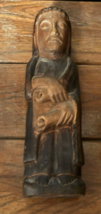 OLD SANTOS FOLK ART SAINT AUGUSTINE ST FRANCIS de SALES NAIVE WOOD SCULPTURE added to cart.
Only one available in stock
OLD SANTOS FOLK ART SAINT AUGUSTINE ST FRANCIS de SALES NAIVE WOOD SCULPTURE added to cart.
Only one available in stock
View Cart or continue shopping.
 Please wait while we finish adding this item to your cart.
Please wait while we finish adding this item to your cart.
Get an item reminder
We'll email you a link to your item now and follow up with a single reminder (if you'd like one). That's it! No spam, no hassle.
Already have an account?
Log in and add this item to your wish list.






